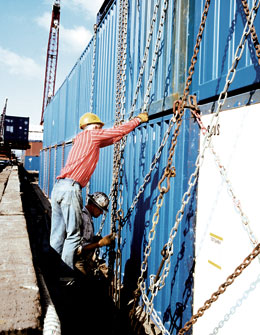 |
 |
 |
|
Producers beware: LHWCA concerns Hidden waterfront exposures could trap the unwary By Jack Martone Producers would never knowingly place clients at unnecessary financial risk, yet some—perhaps many— producers are doing so unknowingly and in the process placing themselves at considerable risk as well. Producers understand the requirement for clients to follow their state’s workers compensation laws. What many may not understand is that when a client’s employee is working on or near a body of water and is injured, state workers compensation laws do not apply. Something called the U.S. Longshore and Harbor Workers’ Compensation Act (LHWCA) does. Tasks as simple as installing a piece of equipment on a large boat, repairing a dock, or wallpapering a cruise ship can fall under LHWCA jurisdiction. And there are serious and expensive consequences for the employer who does not carry LHWCA coverage, whether by intent or oversight. An employer who is responsible for securing LHWCA coverage and fails to do so can be found guilty of a misdemeanor and face a substantial fine and even imprisonment. Further, the officers of an offending company can also be personally liable for the benefits due under the LHWCA, and will not have the benefit of any corporate shield. If a producer fails to advise a client about the existence of the LHWCA and the important need for coverage should the client ever have occasion to work with a business that falls under that Act, they can be subject to an E&O claim if a client’s employee is injured in that environment. There are no hard statistics on the numbers of uninsured clients. Anecdotal evidence, however, suggests the problem is most serious in the Great Lakes states, Florida, and Washington. Shortly after the introduction of state workers compensation laws in the early 20th century, Congress passed the LHWCA because the United States Constitution grants exclusive jurisdiction in all maritime matters to the federal government. Prior to the Act’s passage, a large group of land-based waterfront workers injured on navigable waters of the United States had been denied workers compensation protection. The problem is, too many producers and employers alike know too little about the details of LHWCA and in what circumstances coverage is required. According to the LHWCA, operations that fall under its jurisdiction include any employer of workers who are “employed in maritime employment, in whole or in part, upon the navigable waters of the United States (including any adjoining pier, wharf, dry-dock, terminal, building way, marine railway, or other adjoining area customarily used by an employer in loading, unloading, repairing, or building a vessel).” Many employers and producers may believe the LHWCA applies only to large marine terminals and big shipyards. Not so. The LHWCA covers terminals and facilities of every size, as well as ship or qualified boat-building facilities. Contractors and subcontractors, even those that supply only one worker on a part-time basis, can fall under this Act, and not just businesses on the West, East, or Gulf coasts. Any navigable waterway of the United States falls within the LHWCA, from the Mississippi, Ohio and Missouri Rivers, to the Great Lakes and other inland waters that carry interstate or international commerce. LHWCA coverage is also required of subcontractors, but if an uninsured subcontractor has a claim, the primary contractor can expect to be found liable. Producers need to inform their clients of this potential risk in order to avoid a possible E&O claim. Workers compensation coverage may represent a small percentage of a producer’s book of business. Understandably, producers may then overlook LHWCA coverage or fail to ask the policyholder about the possibility of exposure. Unfortunately, “I never asked about the policyholder’s exposure and the policyholder never told me” may not be an E&O defense for failing to inform insureds of potential LHWCA exposure. Even in cases in which an agent recommends the coverage, a policyholder may decide against taking it to keep costs down. In that situation, make certain that you, as the producer, document your client’s denial of the coverage. Complicating matters is the fact that in years past, many insurers were willing to attach an LHWCA endorsement to an existing workers compensation policy on an “if any” basis for little or no extra premium. That scenario is changing, however; increased exposure and rising costs have prompted many insurers to drop the coverage. As a consequence, producers need to know in advance that a policyholder may perform work that requires LHWCA coverage, how to obtain it, and how to report claims. LHWCA coverage can be obtained from an insurance company or group self-insured fund authorized by the U.S. Department of Labor (DOL), or an employer may become authorized by the Department of Labor to be self-insured. Many large employers opt for the self-insurance route (they must post collateral with the DOL). For all others, however, the insurance or group self-insured fund options are best. To protect both themselves and their policyholders, agents should do the following: • Understand who is subject to the LHWCA. • Be familiar with the consequences if an employer does not have LHWCA coverage. • Identify the DOL-approved sources of LHCWA coverage. • Discuss LHCWA coverage with every commercial policyholder who can so much as “smell salt air.” Question the policyholder to determine if any aspect of operations might fall under the Act’s jurisdiction. * The author |
|
|||||||||||||||||
| ||||||||||||||||||
